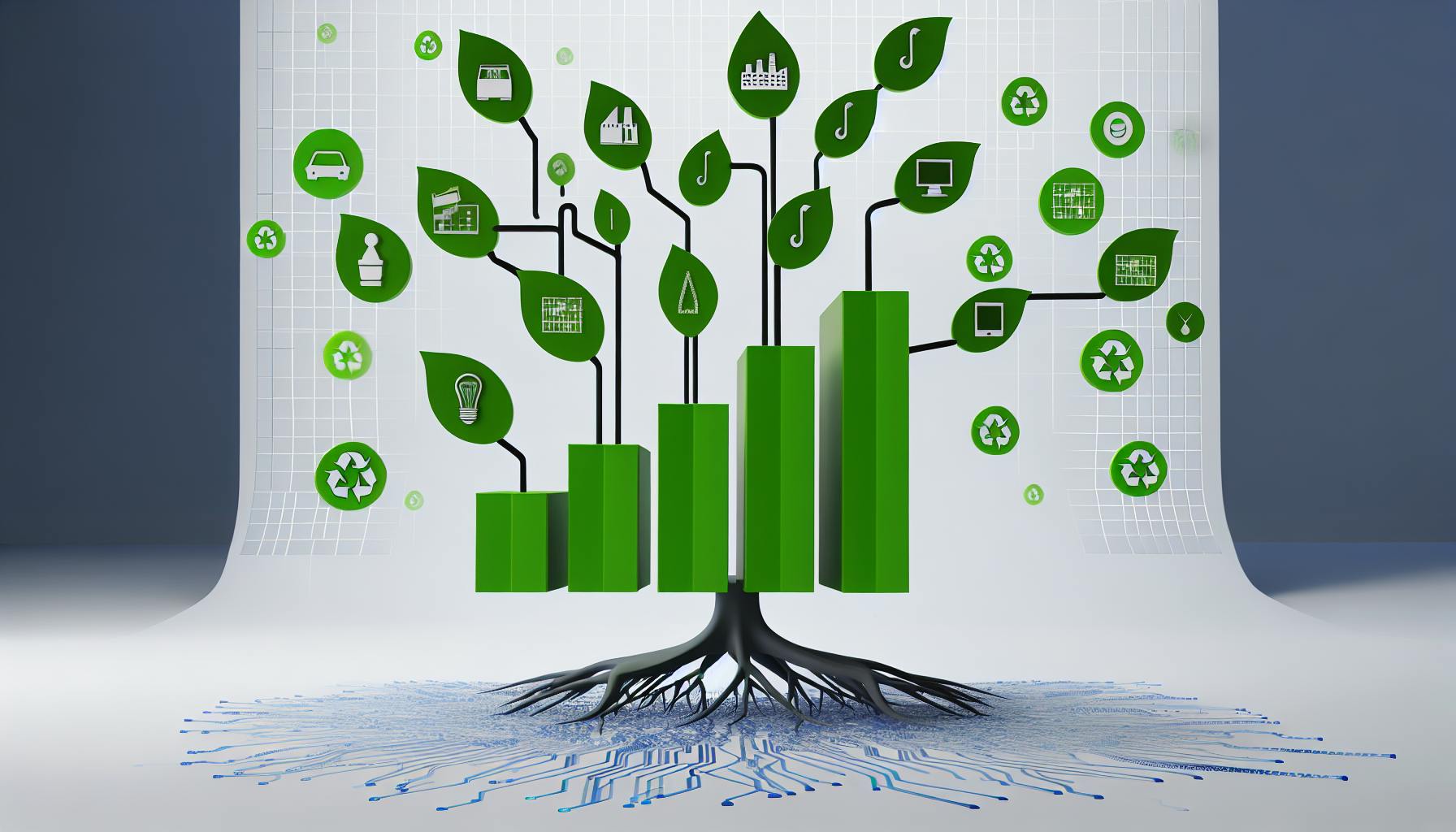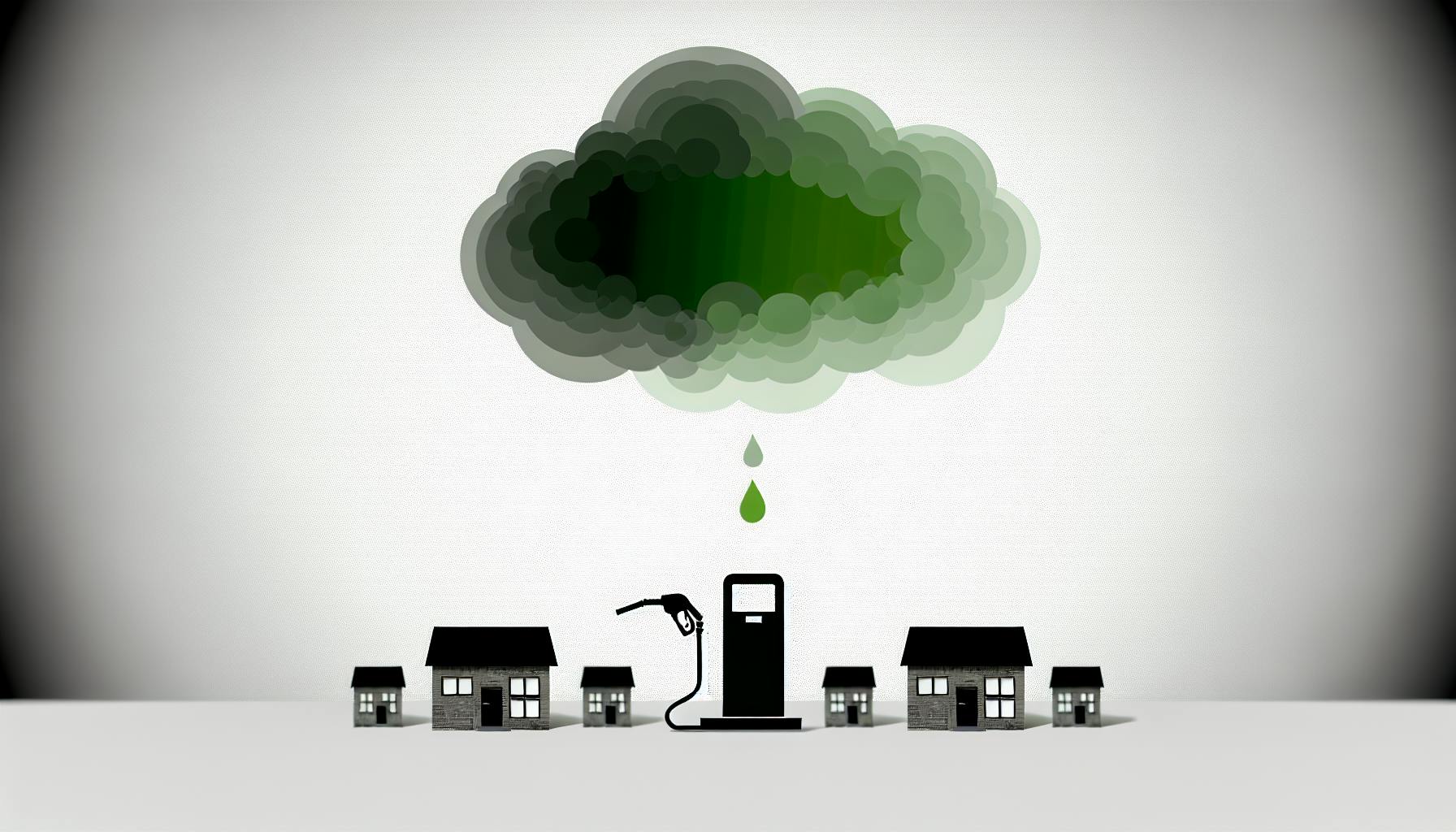Most business owners would agree that accurately measuring and reducing their carbon footprint is an intimidating task.
However, by following a simplified, step-by-step guide, SMEs can effectively calculate, set goals for, and minimize their carbon emissions.
In this post, you'll get an introductory guide to carbon footprints tailored for small and medium enterprises, including the causes and types of emissions, essential calculator tools, real-world carbon footprint examples from other SMEs, and actionable strategies across operations, supply chain, and company culture to reduce your environmental impact.
Introductory Guide to Carbon Footprints for SMEs
Carbon footprint refers to the total greenhouse gas emissions caused directly or indirectly by an individual, organization, event, product or service. It is increasingly used as a sustainability metric by businesses to track and reduce their climate impacts.
For small and medium-sized enterprises (SMEs), measuring carbon footprint can seem complex at first. However, it is an essential step to identify emission sources, set reduction targets, and communicate sustainability initiatives to stakeholders.
This introductory guide will cover:
- What causes carbon emissions and the different types of footprints
- Carbon calculator tools tailored for SMEs
- Real-world examples across industries
With some basic knowledge, SMEs can simplify carbon accounting and use it to their strategic advantage on the path to net zero emissions.
The Basics of Carbon Footprints: Causes and Types
Carbon dioxide (CO2) is the most common greenhouse gas emission from human activities. However, methane, nitrous oxide and other heat-trapping gases also contribute to the carbon footprint.
The main causes are:
- Energy use - Burning fossil fuels for electricity, heating, transportation
- Processes - Chemical reactions during manufacturing
- Land use - Changes in soil/vegetation that release emissions
Carbon footprints are categorized into three scopes by the main reporting standards:
- Scope 1 - Direct emissions from sources owned or controlled by the company (e.g. company vehicles, on-site generators)
- Scope 2 - Indirect emissions from purchased electricity, heating/cooling, or steam
- Scope 3 - All other indirect emissions across the company's value chain
Understanding scope designations is key for SMEs to focus reduction plans on the most material emission sources.
Essential Tools: Carbon Footprint Calculators for SMEs
Carbon calculators tailored to small businesses can automate the quantification of greenhouse gas emissions based on primary data like energy bills as well as industry benchmarks.
Key capabilities SMEs should look for include:
- User-friendly interface - Intuitive for non-experts to operate with minimal training
- Scope 1 & 2 calculations - Quantify on-site fuel usage and purchased electricity/heat
- Supply chain estimates - Model upstream/downstream emissions
- Customization - Configure industry-specific calculations
- Data exports - Extract reports to share with stakeholders
Quality carbon calculators enable SMEs to efficiently produce annual emissions inventories, identify “hot spots”, and track reduction performance over time.
Carbon Footprint Examples: Learning from Real-World SMEs
To illustrate the diversity of SME emission sources and opportunities, here are examples across sectors:
Manufacturing
- A furniture maker reduced natural gas usage for ovens/kilns by 200,000 kWh through a heat recovery retrofit, cutting emissions by 36 metric tonnes of CO2e per year.
Transportation
- A courier company added 20 electric delivery vans, avoiding 160 tonnes of annual tailpipe CO2 emissions versus diesel vans.
Hospitality
- A hotel installed LED lighting, low-flow sink aerators, and upgraded HVAC controls to save $12,000 a year in utility costs and 60 tCO2e.
Technology
- A software firm switched to cloud servers powered by renewable energy, reducing scope 2 emissions by 80% or 120 tCO2e.
These examples showcase realistic actions SMEs can implement today while working toward ambitious long-term carbon neutrality.
What are the main causes of carbon footprint?
The major contributors to carbon footprints are:
- Food: Producing, processing, transporting, storing, cooking, and disposing of food generates significant greenhouse gas emissions. Meat and dairy products tend to have higher carbon footprints due to methane emissions from livestock.
- Consumption of goods and services: The production and distribution of the goods and services we consume leads to carbon dioxide and other greenhouse gas emissions. Things like clothing, electronics, furniture, paper products generate emissions from raw material extraction, manufacturing, transportation and more.
- Transportation: Burning fossil fuels to power cars, trucks, ships, planes, and trains emits carbon dioxide into the atmosphere. Transportation accounts for 14% of global greenhouse gas emissions. Commuting to work, air travel, shipping goods are major contributors.
- Household energy: Heating and cooling homes, hot water usage, lighting, operating appliances and electronic devices consume electricity and natural gas, resulting in carbon dioxide emissions from fossil fuels burned to generate power. Improving efficiency and switching to renewable energy helps cut emissions.
What is the carbon footprint in a short essay?
The carbon footprint refers to the amount of greenhouse gases released into the atmosphere from human activities. It is measured in units of carbon dioxide equivalent and encompasses all six greenhouse gases specified by the Kyoto Protocol.
An organization's carbon footprint typically stems from operations, transportation, purchased goods and services, employee commuting, waste disposal, and other activities. The largest sources usually relate to energy consumption for electricity, heating, and transport fuel.
There are two main methods for calculating carbon footprints - location-based and market-based. The location-based approach considers emissions released within a geographic boundary, while the market-based approach considers emissions from electricity consumption, regardless of where energy generation occurs.
The concept of a carbon footprint helps businesses and individuals understand their climate impact. It also assists in identifying opportunities to reduce emissions through energy efficiency, renewable power, process changes, and other interventions. Tacking the carbon footprint over time allows organizations to track progress and ensure climate targets are achieved.
Which best describes a person's carbon footprint?
A person's carbon footprint refers to the total greenhouse gas emissions caused directly and indirectly by an individual's daily activities. More specifically, it measures the amount of carbon dioxide and other greenhouse gases emitted into the atmosphere as a result of burning fossil fuels for electricity, heating, transportation, and consumption of goods and services.
Some key things that contribute to an individual's carbon footprint include:
- Transportation - Emissions from personal vehicles, air travel, public transport use, etc. Frequent driving and flying contribute greatly to a larger carbon footprint.
- Home energy use - Electricity for appliances, lighting, heating & cooling systems. Larger homes with less efficient systems tend to have higher home energy emissions.
- Diet & consumption - Resource extraction, production, and waste from food, clothing, gadgets, and other products bought. Diets higher in meat and animal products generally have higher carbon footprints.
- Waste - Landfill waste produces methane emissions. Larger volumes of non-recycable and non-compostable waste lead to more emissions.
In summary, a person's individual lifestyle choices related to transportation, energy use, consumption, and waste produce greenhouse gas emissions that contribute to their carbon footprint. By understanding these factors, people can take measures to reduce their environmental impact through simple everyday actions.
sbb-itb-919600f
What is carbon footprint and how do you reduce it?
A carbon footprint refers to the total greenhouse gas emissions caused directly and indirectly by an individual, organization, event or product. It is measured in tons of carbon dioxide equivalent.
There are two main ways companies can reduce their carbon footprint:
- Measure and understand emissions - The first step is to measure your company's carbon footprint using tools like the carbon footprint calculator in EcoHedge software. This allows you to identify the biggest areas to focus reduction efforts.
- Implement emissions reduction strategies - Once major emission sources are found, steps can be taken like improving energy efficiency, switching to renewable energy, reducing business travel, or offsetting unavoidable emissions through certified carbon offset projects.
Small actions like encouraging employees to adopt sustainable commuting options or reducing paper usage can also move the needle. But the most impact often comes from rethinking business operations, product design, facilities and collaboration approaches through a sustainability lens.
With the help of automated tools like EcoHedge, even small and medium businesses can effectively measure, track and reduce the carbon impacts of their operations. This is not only good for the planet - it builds trust and loyalty with an increasingly climate-conscious customer base.
Comprehensive Steps to Measure and Manage Your Carbon Footprint
Managing your company's carbon footprint can seem like a daunting task, but breaking it down into clear, actionable steps makes it much more achievable. As an SME, accurately calculating your emissions baseline is the critical first move.
How Is Carbon Footprint Calculated: A Step-by-Step Guide for SMEs
The key to determining your carbon footprint is gathering data on all direct and indirect emissions from your business operations. Here is an overview of the step-by-step process:
- Track energy usage across facilities - electricity, gas, fuel oil, renewable sources. Collect data on consumption over a 12 month period.
- Log business travel via fleet vehicles, employee vehicles, rail, air. Include commuting where applicable.
- Record materials and waste - raw materials, packaging, office supplies, recycling, and waste output.
- Analyze your supply chain to estimate emissions from procurement, logistics, distribution, and product end-of-life.
- Use emission factors matched to your energy/fuel sources to convert data into metric tons CO2 equivalent.
- Determine scope boundaries - Scope 1 is direct emissions, Scope 2 is indirect from purchased energy, Scope 3 includes value chain emissions.
Online carbon footprint calculators simplify data input and automate conversion calculations. For SMEs, focusing on Scope 1 and 2 creates a solid baseline.
Creating a Baseline and Setting Reduction Goals
Once you've calculated your annual carbon footprint:
- Establish it as your emissions baseline - this is your reference point for goal setting and tracking progress.
- Analyze your data to identify the biggest contributors within your operations - these present reduction opportunities.
- Set an ambitious but realistic goal for decreasing total emissions over 1-5 years - aim for at least 30%.
- Define an annual emissions budget to guide reduction activities and keep you on track to meet longer-term goals.
- Develop specific initiatives across facilities, travel, procurement, etc. Detail implementation plans with timeframes and budget.
- Track and report progress relative to your baseline - share wins with stakeholders to demonstrate commitment.
Regularly revisiting your carbon footprint calculation and realigning goals will help ingrain sustainability into your business strategy. The EcoHedge platform provides automated tracking and detailed reporting to simplify your journey toward net-zero.
Actionable Reduction Strategies: How to Reduce Carbon Footprint
Small and medium-sized enterprises (SMEs) are under increasing pressure to reduce their carbon footprints. As awareness grows around the climate crisis, consumers and investors alike are demanding that companies, regardless of size, take responsibility for their greenhouse gas emissions.
The good news is that with some careful planning, SMEs can implement impactful carbon reduction strategies without breaking the bank. Often, efficiency improvements end up saving money over the long run. This section outlines actionable tactics to lower your business's carbon footprint across operations, supply chain management, and organizational culture.
Optimizing Operational Efficiency
The easiest place for most SMEs to start is by improving energy efficiency. Simple upgrades to lighting, heating, cooling, and industrial equipment can lead to surprisingly large cuts in carbon emissions and energy bills. Some ideas:
- Conduct an energy audit: Learn where energy is being wasted currently, and identify equipment in need of replacement. EcoHedge's software can assist with measuring energy use.
- Implement an energy management system: Monitor real-time energy consumption to optimize usage and identify issues early.
- Upgrade to energy-efficient models: Replace aging, inefficient lighting, HVAC, refrigeration, motors, boilers, and more. Rebates and tax credits often offset upgrade costs.
- Improve building insulation: Prevent costly heat loss by sealing leaks, adding insulation, and upgrading windows/doors.
Enacting robust waste reduction and recycling programs also reduces the embodied carbon emissions from resource extraction and materials production. Simple office changes like reusing paper, limiting printing, and composting food waste make a difference.
Green Supply Chain Management
The emissions from an SME's upstream supply chain often dwarf its direct operations. Engaging suppliers is essential. Strategies like:
- Ask vendors to measure and report emissions: Gain visibility into your supply chain carbon hotspots using EcoHedge software.
- Prioritize local sourcing: Shorter shipping distances substantially lower transport emissions.
- Renegotiate contracts around sustainability: Make emission reductions part of procurement conversations with key suppliers. Offer support and resources if needed.
- Consolidate shipments: Coordinate with vendors to combine deliveries, optimizing logistics networks and reducing miles driven.
As influential customers, SMEs have more power than they realize to drive change up the supply chain.
Fostering a Culture of Sustainability Among Employees
Ultimately, an organization's climate impact comes down to decisions made by individuals every day. Successful carbon reduction requires buy-in across teams. Ways to spur grassroots engagement include:
- Educate staff on sustainability issues: Foster understanding of environmental challenges and your company's role in solutions. EcoHedge's software can help track progress.
- Incentivize innovation: Encourage employees to share ideas for efficiency upgrades, waste reduction, etc. Implement the most promising suggestions.
- Gamify carbon savings: Tap into people's competitive natures by tracking teams' sustainability metrics on leaderboards.
- Give green rewards: Offer bonuses, extra time off, shout-outs, and other benefits to reinforce sustainable actions.
- Hire a sustainability coordinator: Have a go-to expert supporting company-wide emission lowering initiatives.
With some creativity, any SME can ignite a culture shift towards climate-conscious decisions and behaviors company-wide. The collective impact will be tangible emissions reductions.
Monitoring Success: Tracking and Reporting Your Carbon Footprint
Effectively tracking and reporting your carbon footprint is crucial for monitoring the success of your sustainability efforts over time. As an SME aiming to reduce your climate impact, leveraging carbon footprint calculators provides invaluable insights to inform strategic decisions.
Complemented by robust emissions reporting and sustainability storytelling, a continuous measurement approach enables both internal and external stakeholders to comprehend your carbon reduction journey.
Utilizing Carbon Footprint Calculators for Effective Monitoring
Carbon footprint calculators serve as the foundation for reliable tracking of your emissions profile. By inputting data across all scopes and greenhouse gas categories, these tools quantify your total carbon footprint based on transparent calculation methodologies.
Some best practices when using calculators include:
- Selecting an automated calculator that connects directly to your utility, travel, procurement and other emissions data sources. This eliminates manual data entry and ensures accuracy.
- Choosing a calculator that aligns emissions calculations with global GHG protocol standards. This enables benchmarking against industry averages.
- Reviewing both current footprint snapshots as well as historical trends. This equips sustainability teams to report reductions over time.
Best Practices in Emissions Reporting
With ongoing emissions monitoring established, SMEs can instill further trust by proactively publishing sustainability reports summarizing their carbon footprint performance.
Some principles for effective reporting include:
- Highlighting root causes behind current carbon footprint levels based on your business operations. This demonstrates deep understanding of impact.
- Establishing historical baseline years for comparison to showcase emissions reduction success. These should remain consistent year over year.
- Discussing specific initiatives contributing to footprint reductions. This ties progress directly to actions under company control.
Sustainability Storytelling: Sharing Your Carbon Reduction Journey
The process of drafting sustainability reports presents a unique opportunity to share your carbon management story in a compelling way. Some storytelling best practices include:
- Crafting an authentic, human-centered narrative that spotlights sustainability champions within your business. This builds connections.
- Quantifying footprint progress in easily digestible terms, like homes' energy use or acres of forest absorbed. This helps conceptualize achievements.
- Sharing reports not just with leadership and investors but frontline staff as well. This recognizes collective impact in creating footprint change.
With a steady drumbeat of transparent communications on carbon reduction wins, SMEs demonstrate to both internal and external stakeholders their growing sustainability credentials and long-term climate commitments.
Conclusion: Embracing a Low-Carbon Future
As environmental sustainability becomes an increasingly pressing issue, small and medium-sized enterprises must take steps to understand, measure, and reduce their carbon footprint. Though the concept may seem complex, gaining clarity on terminology and methodology is the critical first move.
With growing stakeholder expectations and impending regulations, quantifying and reporting emissions is quickly becoming an operational and reputational necessity. Beyond risk mitigation, sustainability leadership also presents tremendous opportunity to cut costs, engage employees and customers, and future-proof business models.
The path towards net-zero emissions undoubtedly requires short-term investment. However, the long-term dividends - for both business and climate - make action today imperative. By leveraging solutions to automate carbon accounting, SMEs can seamlessly integrate measurement and reporting into existing workflows - saving precious time and resources.
While the climate crisis demands urgent collective response, progress need not be painful. As outlined throughout this guide, simple yet impactful steps can put SMEs on the path towards decarbonization. The future of business is low-carbon - and the time for climate action is now.



